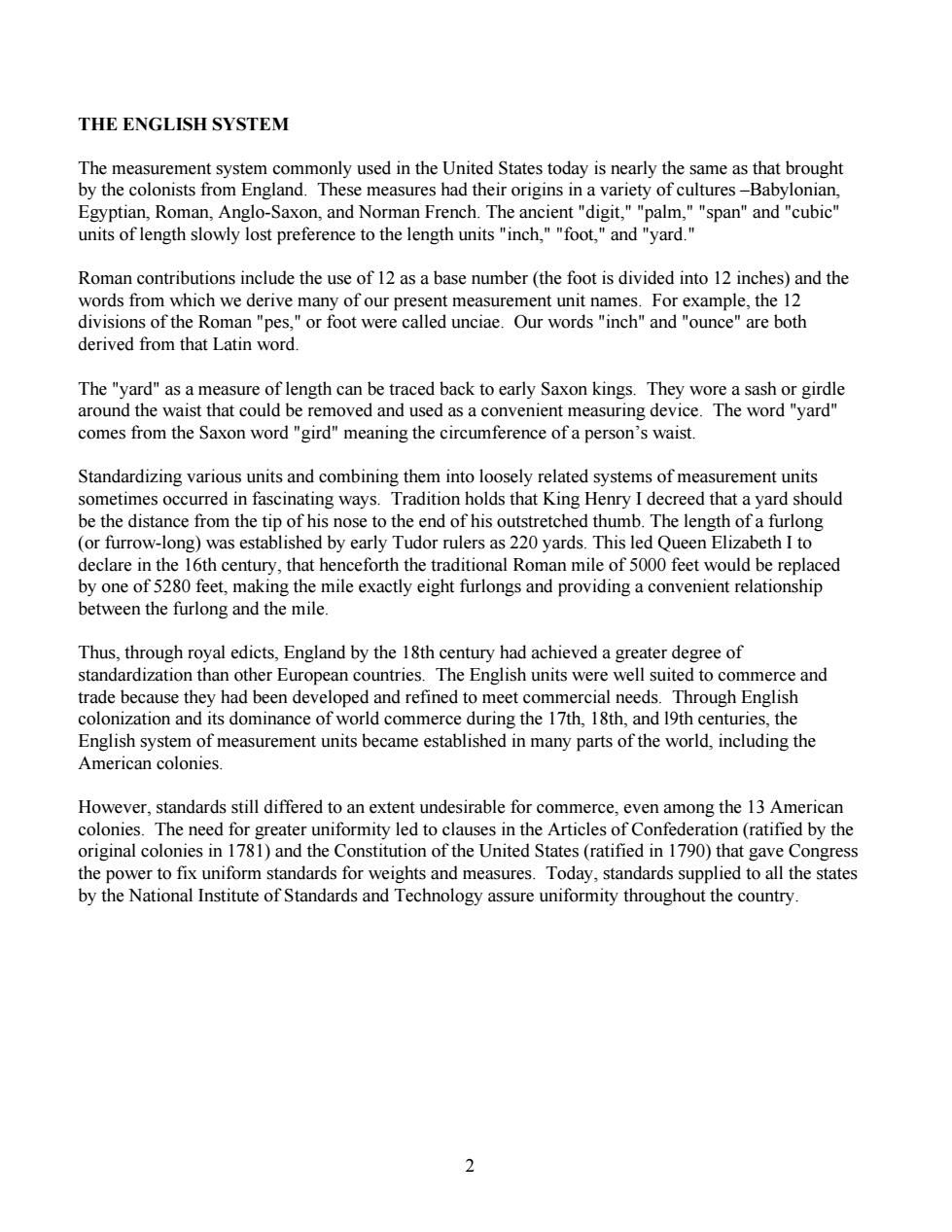正在加载图片...

THE ENGLISH SYSTEM The measurement system commonly used in the United States today is nearly the same as that brought by the colonists from England.These measures had their origins in a variety of cultures-Babylonian, Egyptian,Roman,Anglo-Saxon,and Norman French.The ancient "digit,""palm,""span"and "cubic" units of length slowly lost preference to the length units "inch,""foot,"and "yard." Roman contributions include the use of 12 as a base number (the foot is divided into 12 inches)and the words from which we derive many of our present measurement unit names.For example,the 12 divisions of the Roman "pes,"or foot were called unciae.Our words"inch"and "ounce"are both derived from that Latin word. The "yard"as a measure of length can be traced back to early Saxon kings.They wore a sash or girdle around the waist that could be removed and used as a convenient measuring device.The word "yard" comes from the Saxon word "gird"meaning the circumference of a person's waist. Standardizing various units and combining them into loosely related systems of measurement units sometimes occurred in fascinating ways.Tradition holds that King Henry I decreed that a yard should be the distance from the tip of his nose to the end of his outstretched thumb.The length of a furlong (or furrow-long)was established by early Tudor rulers as 220 yards.This led Queen Elizabeth I to declare in the 16th century,that henceforth the traditional Roman mile of 5000 feet would be replaced by one of 5280 feet,making the mile exactly eight furlongs and providing a convenient relationship between the furlong and the mile. Thus,through royal edicts,England by the 18th century had achieved a greater degree of standardization than other European countries.The English units were well suited to commerce and trade because they had been developed and refined to meet commercial needs.Through English colonization and its dominance of world commerce during the 17th,18th,and 19th centuries,the English system of measurement units became established in many parts of the world,including the American colonies. However,standards still differed to an extent undesirable for commerce,even among the 13 American colonies.The need for greater uniformity led to clauses in the Articles of Confederation(ratified by the original colonies in 1781)and the Constitution of the United States(ratified in 1790)that gave Congress the power to fix uniform standards for weights and measures.Today,standards supplied to all the states by the National Institute of Standards and Technology assure uniformity throughout the country. 2THE ENGLISH SYSTEM The measurement system commonly used in the United States today is nearly the same as that brought by the colonists from England. These measures had their origins in a variety of cultures –Babylonian, Egyptian, Roman, Anglo-Saxon, and Norman French. The ancient "digit," "palm," "span" and "cubic" units of length slowly lost preference to the length units "inch," "foot," and "yard." Roman contributions include the use of 12 as a base number (the foot is divided into 12 inches) and the words from which we derive many of our present measurement unit names. For example, the 12 divisions of the Roman "pes," or foot were called unciae. Our words "inch" and "ounce" are both derived from that Latin word. The "yard" as a measure of length can be traced back to early Saxon kings. They wore a sash or girdle around the waist that could be removed and used as a convenient measuring device. The word "yard" comes from the Saxon word "gird" meaning the circumference of a person’s waist. Standardizing various units and combining them into loosely related systems of measurement units sometimes occurred in fascinating ways. Tradition holds that King Henry I decreed that a yard should be the distance from the tip of his nose to the end of his outstretched thumb. The length of a furlong (or furrow-long) was established by early Tudor rulers as 220 yards. This led Queen Elizabeth I to declare in the 16th century, that henceforth the traditional Roman mile of 5000 feet would be replaced by one of 5280 feet, making the mile exactly eight furlongs and providing a convenient relationship between the furlong and the mile. Thus, through royal edicts, England by the 18th century had achieved a greater degree of standardization than other European countries. The English units were well suited to commerce and trade because they had been developed and refined to meet commercial needs. Through English colonization and its dominance of world commerce during the 17th, 18th, and l9th centuries, the English system of measurement units became established in many parts of the world, including the American colonies. However, standards still differed to an extent undesirable for commerce, even among the 13 American colonies. The need for greater uniformity led to clauses in the Articles of Confederation (ratified by the original colonies in 1781) and the Constitution of the United States (ratified in 1790) that gave Congress the power to fix uniform standards for weights and measures. Today, standards supplied to all the states by the National Institute of Standards and Technology assure uniformity throughout the country. 2